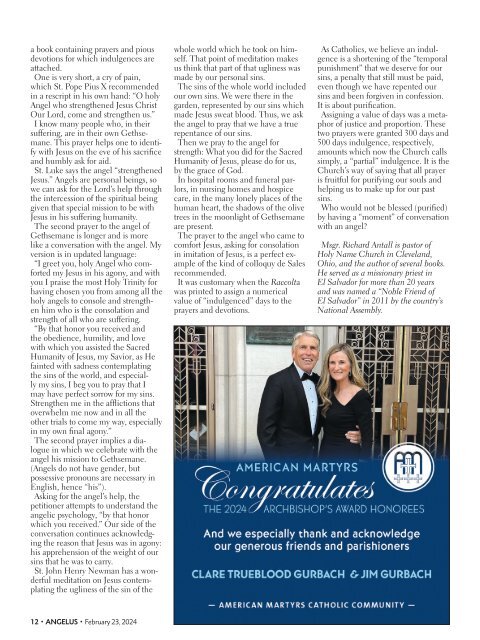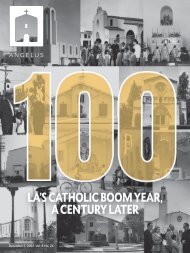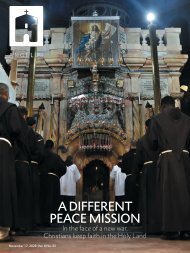Angelus News | February 23, 2024 | Vol. 9 No. 4
On the cover: A painting depicting Jesus in the Garden of Gethsemane by 19th-century artist Carl Heinrich Bloch. For Christians, Lent can be compared to the time Jesus spent praying in the desert. But we may also find ourselves this time of year in the agony of the garden, going through our own Gethsemane of personal suffering. On Page 10, Msgr. Richard Antall reflects on two traditional prayers to the same angel that comforted Christ on the Mount of Olives.
On the cover: A painting depicting Jesus in the Garden of Gethsemane by 19th-century artist Carl Heinrich Bloch. For Christians, Lent can be compared to the time Jesus spent praying in the desert. But we may also find ourselves this time of year in the agony of the garden, going through our own Gethsemane of personal suffering. On Page 10, Msgr. Richard Antall reflects on two traditional prayers to the same angel that comforted Christ on the Mount of Olives.
Create successful ePaper yourself
Turn your PDF publications into a flip-book with our unique Google optimized e-Paper software.
a book containing prayers and pious<br />
devotions for which indulgences are<br />
attached.<br />
One is very short, a cry of pain,<br />
which St. Pope Pius X recommended<br />
in a rescript in his own hand: “O holy<br />
Angel who strengthened Jesus Christ<br />
Our Lord, come and strengthen us.”<br />
I know many people who, in their<br />
suffering, are in their own Gethsemane.<br />
This prayer helps one to identify<br />
with Jesus on the eve of his sacrifice<br />
and humbly ask for aid.<br />
St. Luke says the angel “strengthened<br />
Jesus.” Angels are personal beings, so<br />
we can ask for the Lord’s help through<br />
the intercession of the spiritual being<br />
given that special mission to be with<br />
Jesus in his suffering humanity.<br />
The second prayer to the angel of<br />
Gethsemane is longer and is more<br />
like a conversation with the angel. My<br />
version is in updated language:<br />
“I greet you, holy Angel who comforted<br />
my Jesus in his agony, and with<br />
you I praise the most Holy Trinity for<br />
having chosen you from among all the<br />
holy angels to console and strengthen<br />
him who is the consolation and<br />
strength of all who are suffering.<br />
“By that honor you received and<br />
the obedience, humility, and love<br />
with which you assisted the Sacred<br />
Humanity of Jesus, my Savior, as He<br />
fainted with sadness contemplating<br />
the sins of the world, and especially<br />
my sins, I beg you to pray that I<br />
may have perfect sorrow for my sins.<br />
Strengthen me in the afflictions that<br />
overwhelm me now and in all the<br />
other trials to come my way, especially<br />
in my own final agony.”<br />
The second prayer implies a dialogue<br />
in which we celebrate with the<br />
angel his mission to Gethsemane.<br />
(Angels do not have gender, but<br />
possessive pronouns are necessary in<br />
English, hence “his”).<br />
Asking for the angel’s help, the<br />
petitioner attempts to understand the<br />
angelic psychology, “by that honor<br />
which you received.” Our side of the<br />
conversation continues acknowledging<br />
the reason that Jesus was in agony:<br />
his apprehension of the weight of our<br />
sins that he was to carry.<br />
St. John Henry Newman has a wonderful<br />
meditation on Jesus contemplating<br />
the ugliness of the sin of the<br />
whole world which he took on himself.<br />
That point of meditation makes<br />
us think that part of that ugliness was<br />
made by our personal sins.<br />
The sins of the whole world included<br />
our own sins. We were there in the<br />
garden, represented by our sins which<br />
made Jesus sweat blood. Thus, we ask<br />
the angel to pray that we have a true<br />
repentance of our sins.<br />
Then we pray to the angel for<br />
strength: What you did for the Sacred<br />
Humanity of Jesus, please do for us,<br />
by the grace of God.<br />
In hospital rooms and funeral parlors,<br />
in nursing homes and hospice<br />
care, in the many lonely places of the<br />
human heart, the shadows of the olive<br />
trees in the moonlight of Gethsemane<br />
are present.<br />
The prayer to the angel who came to<br />
comfort Jesus, asking for consolation<br />
in imitation of Jesus, is a perfect example<br />
of the kind of colloquy de Sales<br />
recommended.<br />
It was customary when the Raccolta<br />
was printed to assign a numerical<br />
value of “indulgenced” days to the<br />
prayers and devotions.<br />
As Catholics, we believe an indulgence<br />
is a shortening of the “temporal<br />
punishment” that we deserve for our<br />
sins, a penalty that still must be paid,<br />
even though we have repented our<br />
sins and been forgiven in confession.<br />
It is about purification.<br />
Assigning a value of days was a metaphor<br />
of justice and proportion. These<br />
two prayers were granted 300 days and<br />
500 days indulgence, respectively,<br />
amounts which now the Church calls<br />
simply, a “partial” indulgence. It is the<br />
Church’s way of saying that all prayer<br />
is fruitful for purifying our souls and<br />
helping us to make up for our past<br />
sins.<br />
Who would not be blessed (purified)<br />
by having a “moment” of conversation<br />
with an angel?<br />
Msgr. Richard Antall is pastor of<br />
Holy Name Church in Cleveland,<br />
Ohio, and the author of several books.<br />
He served as a missionary priest in<br />
El Salvador for more than 20 years<br />
and was named a “<strong>No</strong>ble Friend of<br />
El Salvador” in 2011 by the country’s<br />
National Assembly.<br />
12 • ANGELUS • <strong>February</strong> <strong>23</strong>, <strong>2024</strong>

















